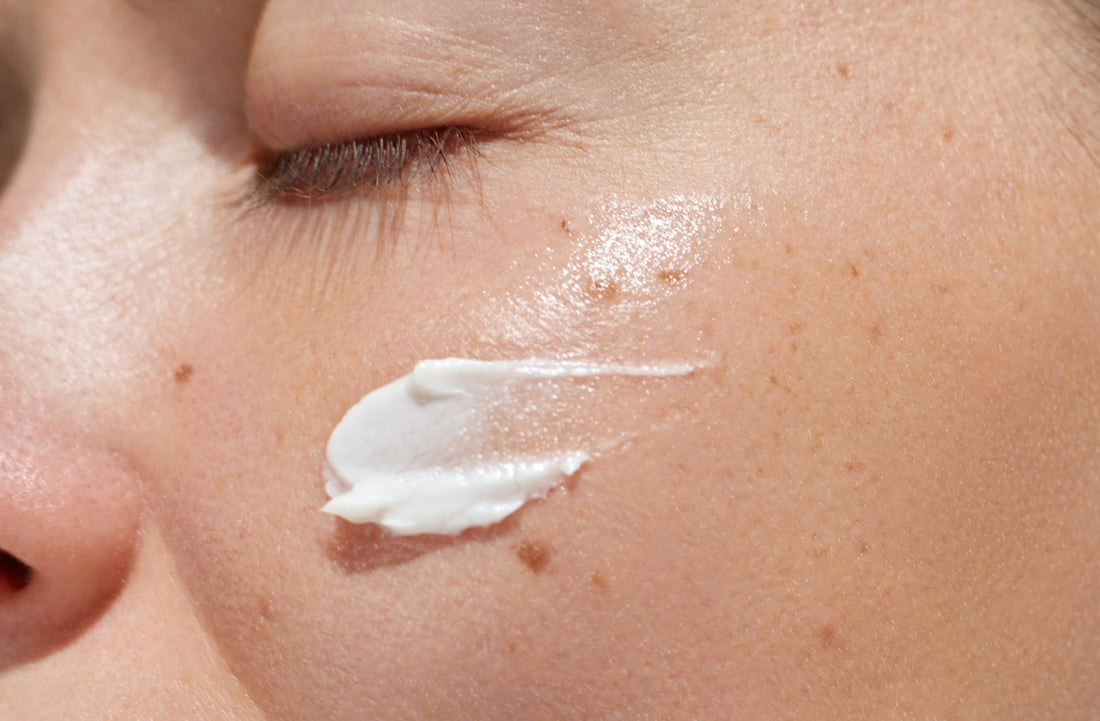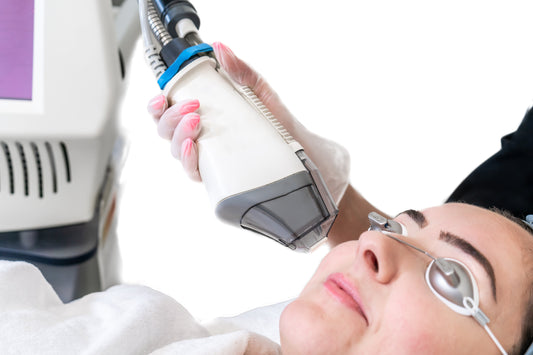Niacinamide is more than just a skincare buzzword or trend. There’s a reason this popular ingredient has made its way into more than a few best-selling skincare products, and that’s because it’s scientifically proven to have benefits for your skin, making it smoother, stronger, and more radiant.
Niacinamide has been shown to be particularly helpful for skin hyperpigmentation, a condition that occurs when skin cells produce too much melanin, causing some patches of skin to appear darker than others (commonly known age spots). Hyperpigmentation may be harmless, but it can leave people feeling self-conscious. If you’re looking to minimize hyperpigmentation, skincare products containing niacinamide can be a great option.
What is Niacinamide?
Niacinamide, sometimes also called nicotinamide, is a type of vitamin B3. Vitamin B3 helps convert the food you eat into energy and aids cells in completing important chemical reactions. Because vitamin B3 is water-soluble, your body doesn’t store it, which means that you need to ingest or use it on a regular basis.
While vitamin B3 can be found in supplements and some foods (usually unknown as nicotinic acid in this context), topical products that contain niacinamide are going to be more beneficial for your skin. Niacinamide is notable for helping to minimize hyperpigmentation, but it has other skincare benefits as well.
Niacinamide Lotion 10%
• Helps retain moisture and elasticity
• Reduces inflammation & redness
Benefits of Using Niacinamide
When used on the skin, niacinamide has antioxidant effects and can help build keratin, a protein that helps keep skin healthy and strong. This can result in a slew of benefits.
- Minimizes redness, skin discoloration, and blotchiness: Niacinamide can help reduce inflammation and strengthen your skin’s barrier, which in turn can help minimize redness and blotchiness from environmental conditions, acne, or rosacea. Studies back this up, showing that using niacinamide on a regular basis over several weeks can significantly improve blotchiness and yellowing.
- Helps control acne: Because niacinamide can reduce inflammation, it can also help control acne. One 2021 study found that regularly using niacinamide for 12 weeks led to a significant reduction in acne, especially when combined with benzoyl peroxide. Or you can try Foundation Skincare’s Azelaic Acid 14% that is a gentler option to help kill the bacteria on the skin’s surface and help reduce acne, along with many other benefits.
- Leaves skin more moisturized: According to Cleveland Clinic, niacinamide can enhance your skin’s lipid barrier, which helps lock in moisture while keeping pollutants and other irritants out. This leaves your skin looking and feeling more hydrated.
- Helps minimize the appearance of pores: Because niacinamide can make skin look more smooth and minimize discoloration, it can also minimize your pores.
- Reduces wrinkles and fine lines: Since niacinamide can increase protein production, it can be helpful in decreasing signs of aging like fine lines and wrinkles. Studies have shown that it can make a noticeable difference in reducing roughness and smoothing out the skin.
- Controls hyperpigmentation: Several studies have shown that niacinamide can significantly improve hyperpigmentation by improving skin’s barrier and reducing the appearance of dark spots.
What Causes Hyperpigmentation
Hyperpigmentation is a common skin condition that causes patches of skin to become darker in color than the rest of the skin, appearing as brown, black, pink, gray, or red spots. According to the American Osteopathic College of Dermatology (ACOD), hyperpigmentation is harmless and happens when the skin produces an excessive amount of melanin, which is the brown pigment that produces your skin color. Too much melanin can cause deposits in the skin that lead to this discoloration.
According to the ACOD and Cleveland Clinic, there are several reasons the skin might produce excess melanin that leads to hyperpigmentation.
- Sun damage or tanning
- Genetics, such as inherited freckles
- Injuries to the skin, such as acne scars
- Hormonal changes during puberty or pregnancy
- Medications, like oral contraceptives
- Melasma
- Not getting enough vitamins like B12 and folic acid
How Niacinamide Works on Hyperpigmentation
Topical niacinamide found in skincare products like serums, moisturizers, and sunscreens can help minimize dark spots, and there’s scientific research that backs this up. For example, a 2000 study that looked at 18 Japanese women who used 5% niacinamide regularly for eight weeks found that the product significantly lighten dark spots caused by hyperpigmentation.
Another 2011 study looked at 27 melasma patients who used 4% niacinamide for eight weeks, and found that after that time, the niacinamide had obviously decreased the hyperpigmentation and reduced inflammation.
But how does it work, exactly? When applied to skin, niacinamide helps to break down existing melanin while also preventing further deposits that might lead to more dark spots. So, not only does niacinamide minimize the appearance of dark spots, but it can also prevent them from developing in the first place.
How to Incorporate Niacinamide Into Your Skincare Routine
It’s easy to start making niacinamide part of your regular skincare routine: you don’t need a prescription to get it. Topical niacinamide can be applied to your skin whether it’s in the form of a serum, moisturizer, sunscreen, or face mask.
Many skincare products will use 5% niacinamide, but amounts will vary depending on the product and brand. Foundation’s Niacinamide Lotion is made with an impressive 10% niacinamide, so it packs a punch. It can help fade dark spots and brighten up the skin by reducing melanin deposits, making it a great option for minimizing hyperpigmentation. But it can also boost collagen to reduce signs of aging, balance sebum to help control and prevent acne, and increase keratin production to tighten up skin and make pores appear smaller. It’s also made with ceramides to keep skin hydrated, soft, and smooth.
You may want to try using niacinamide alongside hyaluronic acid, which can help increase product absorption (and has plenty of benefits on its own). Foundation’s Hyaluronic Acid Lotion can be applied after the Niacinamide Lotion to help boost absorption, moisturize skin, and repair the skin’s barrier to make it stronger and healthier. This lotion can also help reduce the appearance of wrinkles and fine lines and fight dry skin for an overall improvement in skin’s texture.
You can apply niacinamide during both your morning and evening skincare routines every day. Apply it after cleansing and after any other serums you might be using, but before your moisturizer.
Realistic Expectations and Timeline
Don’t expect niacinamide to make a dramatic transformation to your skin overnight. Multiple studies have shown positive benefits from niacinamide after it’s been used on a regular basis for eight to 12 weeks or longer.
It’s important to make niacinamide a part of your daily skincare routine (which should always include using a sunscreen with an SPF 30 or higher) for an extended period of time in order to see results. Regular use of Foundation’s Niacinamide Lotion can make a noticeable difference you can start to see after two to four weeks of consistent daily and nightly use.
If you’re struggling with hyperpigmentation and are looking for a way to reduce your dark spots, niacinamide is a great option. Look for topical niacinamide in the form of lotions or serums, like Foundation’s Niacinamide 10% Lotion, which features a formula created by a dermatologist and pharmacist. Use it on a daily basis to see a reduction in dark spots and discoloration, smoother and more hydrated skin, and a minimization of pores, wrinkles, and fine lines. Find more tips and resources on maintaining healthy hair and skin in the FS Blog.
References:
-
https://www.ncbi.nlm.nih.gov/pmc/articles/PMC2921764/
-
https://my.clevelandclinic.org/health/diseases/21885-hyperpigmentation
-
https://pubmed.ncbi.nlm.nih.gov/18492135/
-
https://www.ncbi.nlm.nih.gov/books/NBK114304/
-
https://health.clevelandclinic.org/niacinamide
-
https://pubmed.ncbi.nlm.nih.gov/17147561/
-
https://pubmed.ncbi.nlm.nih.gov/17147561/
-
https://www.ncbi.nlm.nih.gov/pmc/articles/PMC2921764/
-
https://pubmed.ncbi.nlm.nih.gov/18492135/
-
https://www.ncbi.nlm.nih.gov/pmc/articles/PMC2921764/
-
https://www.ncbi.nlm.nih.gov/pmc/articles/PMC8594539/
-
https://health.clevelandclinic.org/niacinamide
-
https://pubmed.ncbi.nlm.nih.gov/17147561/
-
https://www.ncbi.nlm.nih.gov/pmc/articles/PMC2921764/
-
https://www.ncbi.nlm.nih.gov/pmc/articles/PMC2921764/
-
https://www.aocd.org/page/Hyperpigmentation
-
https://pubmed.ncbi.nlm.nih.gov/10971324/
-
ncbi.nlm.nih.gov/pmc/articles/PMC3142702/
-
https://pubmed.ncbi.nlm.nih.gov/12100180
-
https://my.clevelandclinic.org/health/articles/22915-hyaluronic-acid
-
https://www.ncbi.nlm.nih.gov/pmc/articles/PMC2921764/





